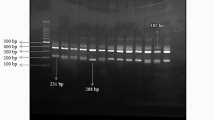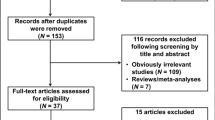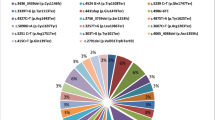Abstract
Genome-wide association studies (GWAS) have identified common variants associated with breast cancer (BC) risk at multiple genetic loci. Above all, accumulated evidence suggests that inherited risk variants may vary in BC subtypes defined by estrogen receptor (ER) or progesterone receptor (PR) status. However, the underlying susceptibility of some variants for BC subtypes has not been well investigated in the Chinese population. Our objective was to explore the association among 23 GWAS-identified single-nucleotide polymorphisms (SNPs) and overall BC incidence, as well as its subtypes, in Chinese women. An extensive association analysis using the Sequenom MassARRAY® platform was conducted in a case–control study, including 551 BC patients and 577 healthy controls. Using the chi-squared (χ2) test and genetic model analysis, we found an association with BC for four SNPs (rs616488 (1p36.22/PEX14), rs6678914 (1q32.1/LGR6), rs17530068 (6q14/unknown) and rs6001930 (22q13.1/MKL1)) at a 5% level. Stratified analyses under this genetic model determined that rs616488 and rs6001930 were specific to ER positive and PR positive, rs17530068 was specific to ER positive and PR negative, rs3817198 (11p15.5/LSP1) was specific to ER negative and rs4784227 (16q12.1/CASC16) was specific to PR positive. Our study provides powerful new evidence for the relationship between SNPs and BC susceptibility.
Similar content being viewed by others
Log in or create a free account to read this content
Gain free access to this article, as well as selected content from this journal and more on nature.com
or
References
Siegel, R., Naishadham, D. & Jemal, A. Cancer statistics, 2013. CA Cancer J. Clin. 63, 11–30 (2013).
Ring, A. & Dowsett, M. Mechanisms of tamoxifen resistance. Endocr. Relat. Cancer 11, 643–658 (2004).
Perou, C. M., Sørlie, T., Eisen, M. B., van de Rijn, M., Jeffrey, S. S., Rees, C. A. et al. Molecular portraits of human breast tumours. Nature 406, 747–752 (2000).
Reis-Filho, J., Westbury, C. & Pierga, J. The impact of expression profiling on prognostic and predictive testing in breast cancer. J. Clin. Pathol. 59, 225–231 (2006).
Rouzier, R., Wagner, P., Morandi, P. & Pusztai, L. Gene expression profiling of primary breast cancer. Curr. Oncol. Rep. 7, 38–44 (2005).
Anderson, W. F., Chatterjee, N., Ershler, W. B. & Brawley, O. W. Estrogen receptor breast cancer phenotypes in the Surveillance, Epidemiology, and End Results database. Breast Cancer Res. Treat. 76, 27–36 (2002).
Niemeier, L. A., Dabbs, D. J., Beriwal, S., Striebel, J. M. & Bhargava, R. Androgen receptor in breast cancer: expression in estrogen receptor-positive tumors and in estrogen receptor-negative tumors with apocrine differentiation. Mod. Pathol. 23, 205–212 (2010).
Nathanson, K. N., Wooster, R. & Weber, B. L. Breast cancer genetics: what we know and what we need. Nat. Med. 7, 552–556 (2001).
Zhang, B., Beeghly-Fadiel, A., Long, J. & Zheng, W. Genetic variants associated with breast-cancer risk: comprehensive research synopsis, meta-analysis, and epidemiological evidence. Lancet Oncol. 12, 477–488 (2011).
Benson, J. R. & Jatoi, I. The global breast cancer burden. Fut. Oncol. 8, 697–702 (2012).
Easton, D. F., Pooley, K. A., Dunning, A. M., Pharoah, P. D., Thompson, D., Ballinger, D. G. et al. Genome-wide association study identifies novel breast cancer susceptibility loci. Nature 447, 1087–1093 (2007).
Garcia-Closas, M., Couch, F. J., Lindstrom, S., Michailidou, K., Schmidt, M. K., Brook, M. N. et al. Genome-wide association studies identify four ER negative-specific breast cancer risk loci. Nat. Genet. 45, 392–398 (2013).
He, X., Yao, G., Li, F., Li, M. & Yang, X. Risk-association of five SNPs in TOX3/LOC643714 with breast cancer in southern China. Int. J. Mol. Sci. 15, 2130–2141 (2014).
Long, J., Zhang, B., Signorello, L. B., Cai, Q., Deming-Halverson, S., Shrubsole, M. J. et al. Evaluating genome-wide association study-identified breast cancer risk variants in African-American women. PLoS ONE 8, e58350 (2013).
Purrington, K. S., Slager, S., Eccles, D., Yannoukakos, D., Fasching, P. A., Miron, P. et al. Genome-wide association study identifies 25 known breast cancer susceptibility loci as risk factors for triple-negative breast cancer. Carcinogenesis 35, 1012–1019 (2014).
Siddiq, A., Couch, F. J., Chen, G. K., Lindström, S., Eccles, D., Millikan, R. C. et al. A meta-analysis of genome-wide association studies of breast cancer identifies two novel susceptibility loci at 6q14 and 20q11. Hum. Mol. Genet. 21, 5373–5384 (2012).
Yu, Y., Chen, Z., Wang, H. & Zhang, Y. Quantitative assessment of common genetic variants on chromosome 5p12 and hormone receptor status with breast cancer risk. PLoS ONE 8, e72154 (2013).
Zheng, W., Zhang, B., Cai, Q., Sung, H., Michailidou, K., Shi, J. et al. Common genetic determinants of breast-cancer risk in East Asian women: a collaborative study of 23 637 breast cancer cases and 25 579 controls. Hum. Mol. Genet. 22, 2539–2550 (2013).
Broeks, A., Schmidt, M. K., Sherman, M. E., Couch, F. J., Hopper, J. L., Dite, G. S. et al. Low penetrance breast cancer susceptibility loci are associated with specific breast tumor subtypes: findings from the Breast Cancer Association Consortium. Hum. Mol. Genet. 20, 3289–3303 (2011).
Garcia-Closas, M. & Chanock, S. Genetic susceptibility loci for breast cancer by estrogen receptor status. Clin. Cancer Res. 14, 8000–8009 (2008).
Reeves, G. K., Travis, R. C., Green, J., Bull, D., Tipper, S., Baker, K. et al. Incidence of breast cancer and its subtypes in relation to individual and multiple low-penetrance genetic susceptibility loci. JAMA 304, 426–434 (2010).
Stacey, S. N., Manolescu, A., Sulem, P., Rafnar, T., Gudmundsson, J., Gudjonsson, S. A. et al. Common variants on chromosomes 2q35 and 16q12 confer susceptibility to estrogen receptor–positive breast cancer. Nat. Genet. 39, 865–869 (2007).
Michailidou, K., Hall, P., Gonzalez-Neira, A., Ghoussaini, M., Dennis, J., Milne, R. L. et al. Large-scale genotyping identifies 41 new loci associated with breast cancer risk. Nat. Genet. 45, 353–361 (2013).
Turnbull, C., Ahmed, S., Morrison, J., Pernet, D., Renwick, A., Maranian, M. et al. Genome-wide association study identifies five new breast cancer susceptibility loci. Nat. Genet. 42, 504–507 (2010).
Sehrawat, B., Sridharan, M., Ghosh, S., Robson, P., Cass, C. E., Mackey, J. R. et al. Potential novel candidate polymorphisms identified in genome-wide association study for breast cancer susceptibility. Hum. Genet. 130, 529–537 (2011).
Li, J., Humphreys, K., Heikkinen, T., Aittomäki, K., Blomqvist, C., Pharoah, P. D. et al. A combined analysis of genome-wide association studies in breast cancer. Breast Cancer Res. Treat. 126, 717–727 (2011).
Cai, Q., Long, J., Lu, W., Qu, S., Wen, W., Kang, D. et al. Genome-wide association study identifies breast cancer risk variant at 10q21. 2: results from the Asia Breast Cancer Consortium. Hum. Mol. Genet. 20, 4991–4999 (2011).
Long, J., Cai, Q., Shu, X.-O., Qu, S., Li, C., Zheng, Y. et al. Identification of a functional genetic variant at 16q12. 1 for breast cancer risk: results from the Asia Breast Cancer Consortium. PLoS Genet. 6, e1001002 (2010).
Fletcher, O., Johnson, N., Orr, N., Hosking, F. J., Gibson, L. J., Walker, K. et al. Novel breast cancer susceptibility locus at 9q31. 2: results of a genome-wide association study. J. Natl Cancer Inst. 103, 425–435 (2011).
Brooks, P. C., Silletti, S., von Schalscha, T. L., Friedlander, M. & Cheresh, D. A. Disruption of angiogenesis by PEX, a noncatalytic metalloproteinase fragment with integrin binding activity. Cell 92, 391–400 (1998).
Shimizu, N., Itoh, R., Hirono, Y., Otera, H., Ghaedi, K., Tateishi, K. et al. The peroxin Pex14p cDNA cloning by functional complementation on a Chinese hamster ovary cell mutant, characterization, and functional analysis. J. Biol. Chem. 274, 12593–12604 (1999).
Ohira, M., Kageyama, H., Mihara, M., Furuta, S., Machida, T., Shishikura, T. et al. Identification and characterization of a 500-kb homozygously deleted region at 1p36. 2-p36. 3 in a neuroblastoma cell line. Oncogene 19, 4302–4307 (2000).
Turashvili, G., Bouchal, J., Baumforth, K., Wei, W., Dziechciarkova, M., Ehrmann, J. et al. Novel markers for differentiation of lobular and ductal invasive breast carcinomas by laser microdissection and microarray analysis. BMC Cancer 7, 1 (2007).
Sawyer, E., Roylance, R., Petridis, C., Brook, M. N., Nowinski, S., Papouli, E. et al. Genetic predisposition to in situ and invasive lobular carcinoma of the breast. PLoS Genet. 10, e1004285 (2014).
Lagali, P., Kakuk, L., Griesinger, I., Wong, P. & Ayyagari, R. Identification and characterization of C6orf37, a novel candidate human retinal disease gene on chromosome 6q14. Biochem. Biophys. Res. Commun. 293, 356–365 (2002).
Etokebe, G. E., Küchler, A. M., Haraldsen, G., Landin, M., Osmundsen, H. & Dembic, Z. Family-with-sequence-similarity-46, member A (Fam46a) gene is expressed in developing tooth buds. Arch. Oral Biol. 54, 1002–1007 (2009).
Bernardo, G. M. & Keri, R. A. FOXA1: a transcription factor with parallel functions in development and cancer. Biosci. Rep. 32, 113–130 (2012).
Cowper-Sal, R., Zhang, X., Wright, J. B., Bailey, S. D., Cole, M. D., Eeckhoute, J. et al. Breast cancer risk-associated SNPs modulate the affinity of chromatin for FOXA1 and alter gene expression. Nat. Genet. 44, 1191–1198 (2012).
Lin, Y., Fu, F., Chen, M., Huang, M. & Wang, C. Associations of two common genetic variants with breast cancer risk in a Chinese population: a stratified interaction analysis. PLoS ONE 9 (2014).
Thomas, D. C. & Witte, J. S. Point: population stratification: a problem for case-control studies of candidate-gene associations? Cancer Epidemiol. Biomarkers Prev. 11, 505–512 (2002).
Milne, R. L., Benítez, J., Nevanlinna, H., Heikkinen, T., Aittomäki, K., Blomqvist, C. et al. Risk of estrogen receptor-positive and -negative breast cancer and single-nucleotide polymorphism 2q35-rs13387042. J. Natl Cancer Inst. 101, 1012–1018 (2009).
Acknowledgements
This study was funded by the 2013 Science and Technology Department of Shaanxi Province Natural Science Foundation Project (No. 2013JM4035) and 2013 National Natural Science Foundation of China. We are grateful to the BC patients and control subjects for their participation in this study. We also thank the clinicians and hospital staff who contributed to the sample and data collection.
Author information
Authors and Affiliations
Corresponding author
Ethics declarations
Competing interests
The authors declare no conflict of interest.
Rights and permissions
About this article
Cite this article
Deng, Z., Yang, H., Liu, Q. et al. Identification of novel susceptibility markers for the risk of overall breast cancer as well as subtypes defined by hormone receptor status in the Chinese population. J Hum Genet 61, 1027–1034 (2016). https://doi.org/10.1038/jhg.2016.97
Received:
Revised:
Accepted:
Published:
Issue date:
DOI: https://doi.org/10.1038/jhg.2016.97
This article is cited by
-
Impact of NR5A2 and RYR2 3′UTR polymorphisms on the risk of breast cancer in a Chinese Han population
Breast Cancer Research and Treatment (2020)
-
Genetic determinants of sporadic breast cancer in Sri Lankan women
BMC Cancer (2018)
-
FAM46B inhibits cell proliferation and cell cycle progression in prostate cancer through ubiquitination of β-catenin
Experimental & Molecular Medicine (2018)



